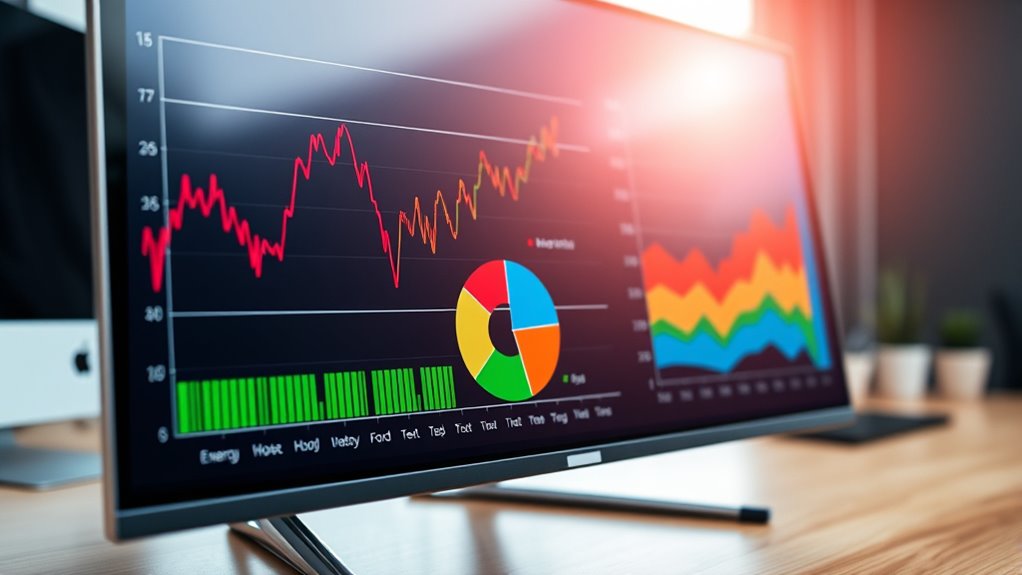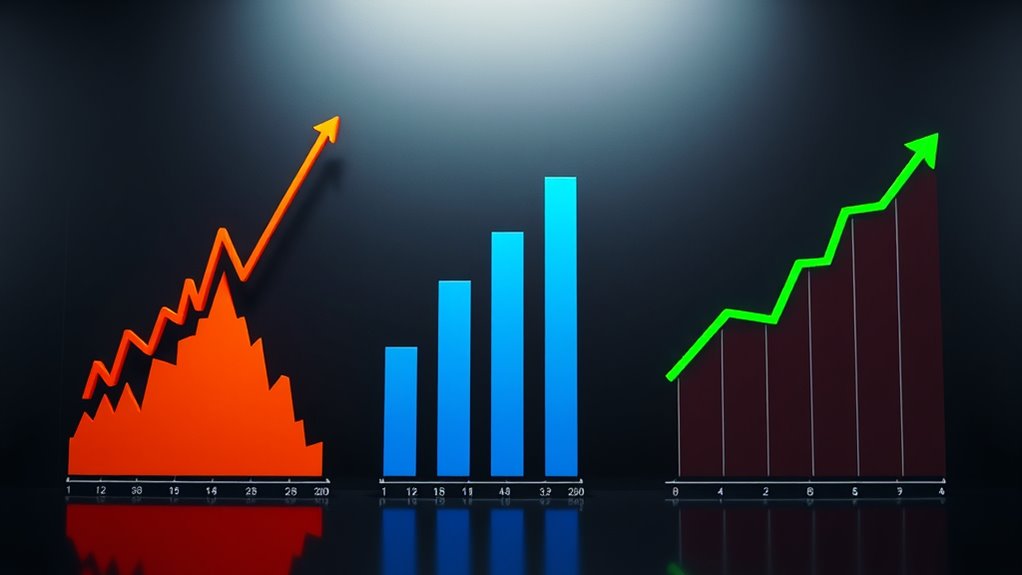To understand what’s driving prices, look at charts showing how central banks’ interest rate changes affect inflation by controlling demand. Also, consider supply chain disruptions that cause shortages and push prices higher. Finally, examine demand trends and how consumer spending can outpace supply, fueling inflation. These visuals reveal how monetary policy, supply issues, and demand shifts intertwine. Keep exploring to see how these factors shape the economic landscape more clearly.
Key Takeaways
- Inflation is driven by demand exceeding supply, often influenced by monetary policy adjustments like interest rate changes.
- Supply chain disruptions cause shortages, leading to higher prices for affected goods and fueling inflation.
- Lower interest rates encourage borrowing and spending, which can increase demand and push prices upward.
- Rising prices reduce consumers’ purchasing power, creating a cycle that sustains inflation over time.
- Visual data and charts help illustrate how monetary policy and supply issues jointly impact inflation trends.

Have you ever wondered what causes prices to rise and how it affects your daily life? Understanding inflation is key to grasping why the cost of groceries, fuel, or housing keeps climbing. One of the main drivers behind these rising prices is the role of monetary policy. When central banks, like the Federal Reserve, decide to lower interest rates, they make borrowing cheaper. This encourages consumers and businesses to spend more money, but it can also lead to increased demand that outpaces supply. When demand exceeds supply, prices naturally go up. On the flip side, if the central bank raises interest rates to cool down the economy, borrowing becomes more expensive, which can slow spending and help keep inflation in check. But monetary policy isn’t the only factor at play. Supply chains, which are the networks that move goods from producers to consumers, also heavily influence inflation. Disruptions in these supply chains—whether caused by natural disasters, geopolitical conflicts, or logistical issues—delay the delivery of goods. When products take longer to reach shelves, shortages occur, and prices tend to jump. For example, during recent global events, supply chain disruptions contributed profoundly to the spike in prices for electronics, cars, and even food. You might notice that when a product is in short supply, stores charge more, partly because they face higher costs and partly because buyers are willing to pay a premium to get what they need. These supply chain issues aren’t just temporary hiccups; they can have lasting effects, especially when combined with inflationary pressures from monetary policy decisions. As prices rise, your purchasing power shrinks, making it harder to afford the same goods and services as before. This interaction creates a cycle where inflation feeds on itself unless policies and supply chain issues are addressed effectively. The charts you’re about to see will illustrate how these factors intertwine over time, showing how monetary policy shifts and supply chain disruptions have historically driven inflation. By understanding these connections, you’ll gain insight into why prices fluctuate and how policymakers try to manage inflation without stifling economic growth. Whether it’s central banks adjusting interest rates or efforts to streamline global logistics, these elements constantly influence the prices you encounter daily. Recognizing their roles helps demystify the complex process behind inflation and empowers you to make more informed financial decisions. In the end, inflation isn’t just about rising numbers; it’s about the intricate dance between policies, supply chains, and consumer behavior that impacts your wallet every day. Moreover, understanding the importance of color accuracy in visual representations can help you interpret economic data more effectively. Additionally, awareness of economic indicators can enhance your understanding of market trends and inflation dynamics. Understanding how monetary policy influences inflation can also help you anticipate future price movements and adjust your financial plans accordingly. Recognizing the impact of supply chain disruptions can further prepare you for potential fluctuations in prices due to unforeseen logistical issues.
Frequently Asked Questions
How Does Inflation Impact Everyday Consumer Decisions?
Inflation influences your everyday consumer decisions by reducing your purchasing power, making goods and services more expensive. As prices rise, you may change your consumer habits, such as buying fewer luxury items or seeking discounts. You might also prioritize essential items over non-essentials. Understanding inflation helps you make smarter choices, ensuring you manage your budget effectively and adapt to changing prices without sacrificing your financial stability.
What Role Do Government Policies Play in Inflation Trends?
You might think government policies don’t matter much, but they actually play a huge role in inflation trends. When you see fiscal stimulus, it can boost spending and prices. Regulatory impacts, like changes in banking or trade rules, can also influence inflation by affecting costs and supply chains. So, government actions directly shape how prices rise or fall, impacting your everyday expenses more than you might realize.
How Can Individuals Protect Their Savings From Inflation?
To safeguard your savings from inflation, you should explore effective investor strategies focused on savings preservation. Consider diversifying your portfolio with assets like stocks, real estate, or inflation-protected securities. Keep an eye on interest rates and inflation trends, adjusting your investments accordingly. Regularly review and rebalance your portfolio to ensure your savings grow faster than inflation, helping you maintain your purchasing power over time.
Are Certain Industries More Affected by Inflation Than Others?
You might notice that industry disparities affect how sectors experience inflation. Certain industries, like housing or energy, are more sensitive to price changes, making them more affected by inflation. Sector sensitivities vary based on factors like raw material costs or demand shifts. Understanding these differences helps you anticipate which industries may see bigger price swings, allowing you to make smarter investment decisions or manage your expenses more effectively during inflationary periods.
What Are the Long-Term Economic Consequences of Sustained Inflation?
You should consider that sustained inflation can lead to long-term economic issues like decreased purchasing power and increased cost of living. It often prompts policymakers to tighten monetary policy, which can slow growth. Additionally, you might experience wage stagnation, making it harder to keep up with rising prices. Over time, persistent inflation could undermine economic stability and reduce your overall quality of life.
Conclusion
As you navigate these charts, remember that understanding inflation isn’t about controlling every ripple but recognizing the subtle currents beneath. While prices may seem to rise and fall, they often reflect broader shifts, not just momentary waves. By staying attentive and adaptable, you can find your steady course amid the changing tides, knowing that even in complexity, there’s a rhythm that, with patience, you can come to understand and work with.
Amina brings over a decade of journalism experience to her role as Editor-in-Chief. Under her leadership, Exquisite Post has flourished, maintaining the highest standards of integrity and excellence. Amina’s commitment to truth and her visionary approach guide the editorial team in producing impactful news stories that resonate with our audience.










